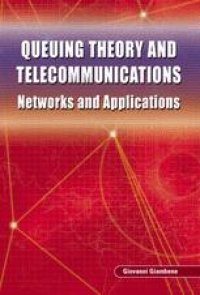
Ebook: Queuing Theory and Telecommunications: Networks and Applications
Author: Giovanni Giambene (auth.)
Queuing Theory and Telecommunications : Networks and Applications provides some fundamental knowledge in queuing theory, as well as essential analytical methods and approaches to be employed to evaluate and design telecommunication networks.
This work provides methods for teletraffic analysis as well as descriptions of current network technologies such as ISDN, B-ISDN, IP-based networks, MPLS, GMPLS, NGN and local access systems, including ADSL-based, Ethernet, Token Passing, and WiFi. Also, numerous solved exercises are provided in order to illustrate the applications of queuing theory in telecommunication networks. The following advanced telecommunication problems are modeled and solved by means of queuing analysis: statistics of the transmission delay for packet data traffic arriving at a transmission buffer; blocking behavior for bursty call arrival processes; characterization of Markovian traffic sources; performance of traffic regulators, analysis of access protocols and more. The author provides readers with a correct understanding of fundamental methods to be applied in the analysis of telecommunications systems.
Queuing Theory and Telecommunications : Networks and Applicationsis a reference text for advanced undergraduate and graduate level courses in telecommunications engineering and networking. It will also serve as a useful work for system engineers involved in network dimensioning.
Queuing Theory and Telecommunications : Networks and Applications provides some fundamental knowledge in queuing theory, as well as essential analytical methods and approaches to be employed to evaluate and design telecommunication networks.
This work provides methods for teletraffic analysis as well as descriptions of current network technologies such as ISDN, B-ISDN, IP-based networks, MPLS, GMPLS, NGN and local access systems, including ADSL-based, Ethernet, Token Passing, and WiFi. Also, numerous solved exercises are provided in order to illustrate the applications of queuing theory in telecommunication networks. The following advanced telecommunication problems are modeled and solved by means of queuing analysis: statistics of the transmission delay for packet data traffic arriving at a transmission buffer; blocking behavior for bursty call arrival processes; characterization of Markovian traffic sources; performance of traffic regulators, analysis of access protocols and more. The author provides readers with a correct understanding of fundamental methods to be applied in the analysis of telecommunications systems.
Queuing Theory and Telecommunications : Networks and Applicationsis a reference text for advanced undergraduate and graduate level courses in telecommunications engineering and networking. It will also serve as a useful work for system engineers involved in network dimensioning.
Content:
Front Matter....Pages i-xix
Introduction to Telecommunication Networks....Pages 3-67
Digital Networks....Pages 69-149
IP-Based Networks....Pages 151-234
Survey on Probability Theory....Pages 237-304
Markov Chains and Queuing Theory....Pages 305-383
M/G/1 Queuing Theory and Applications....Pages 385-448
Local Area Networks Analysis....Pages 449-555
Networks of Queues....Pages 557-580
Back Matter....Pages 581-585
Queuing Theory and Telecommunications : Networks and Applications provides some fundamental knowledge in queuing theory, as well as essential analytical methods and approaches to be employed to evaluate and design telecommunication networks.
This work provides methods for teletraffic analysis as well as descriptions of current network technologies such as ISDN, B-ISDN, IP-based networks, MPLS, GMPLS, NGN and local access systems, including ADSL-based, Ethernet, Token Passing, and WiFi. Also, numerous solved exercises are provided in order to illustrate the applications of queuing theory in telecommunication networks. The following advanced telecommunication problems are modeled and solved by means of queuing analysis: statistics of the transmission delay for packet data traffic arriving at a transmission buffer; blocking behavior for bursty call arrival processes; characterization of Markovian traffic sources; performance of traffic regulators, analysis of access protocols and more. The author provides readers with a correct understanding of fundamental methods to be applied in the analysis of telecommunications systems.
Queuing Theory and Telecommunications : Networks and Applicationsis a reference text for advanced undergraduate and graduate level courses in telecommunications engineering and networking. It will also serve as a useful work for system engineers involved in network dimensioning.
Content:
Front Matter....Pages i-xix
Introduction to Telecommunication Networks....Pages 3-67
Digital Networks....Pages 69-149
IP-Based Networks....Pages 151-234
Survey on Probability Theory....Pages 237-304
Markov Chains and Queuing Theory....Pages 305-383
M/G/1 Queuing Theory and Applications....Pages 385-448
Local Area Networks Analysis....Pages 449-555
Networks of Queues....Pages 557-580
Back Matter....Pages 581-585
....